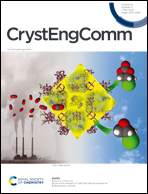An Sc-based coordination polymer with concaved superstructures: preparation, formation mechanism, conversion, and their electrochemistry properties†
Abstract
In this study, metastable Sc-based coordination polymer (ScCP) octahedrons with a diameter of about 5 μm have been fabricated via a facile solvothermal method. The ScCP octahedrons were constructed from numerous nanoparticles, with sizes ranging from 10–20 nm, via a self-assembly process. Interestingly, ScCP octahedrons with concaved surfaces are seldom reported in the literature owing to major challenges associated with high surface energies and unfavorable thermodynamics. The influence of the reaction temperature, reaction time, and molar ratio of the reagents on the size and morphology of the as-prepared products was systematically investigated, and a possible formation mechanism for the concaved ScCP octahedron has been proposed. At lower temperatures, the ScCP octahedrons grow via a conventional Ostwald ripening route. While a mesoscopic self-assembly process is suggested at higher temperatures. Sc2O3/C octahedrons were obtained after simple calcination in an N2 atmosphere and the electrochemical properties were studied. It is believed that this facile synthesis may give guidance for the preparation of CPs with complex morphologies.



 Please wait while we load your content...
Please wait while we load your content...